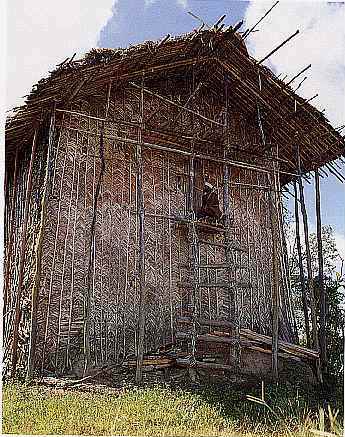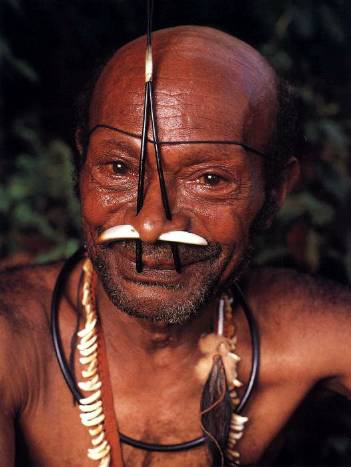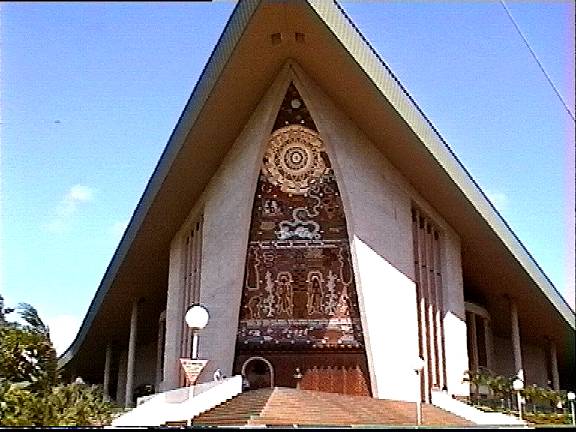A Brief History of NewguineaTo understand, what it meant to people, their culture, and the state of PNG, to introduce big mining projects like Ok Tedi Mine to the country, history and mining on New Guinea are described briefly.The inhabitants of Newguinea scarcely left durable signs of their existence. Therefore it is very difficult, to dig and to date the history of development on the island. Boldest estimates say, immigration from the Asian continent and the Indonesian islands started 80,000 years ago, more cautious archaeologists assume 50,000 years. The immigrants had to cross the sea, because even at the maximum of glacialisation, which means lowest sea level, there was no land bridge to the Australian plate. Otherwise, land animals from Asia, and marsupials from Australia, were to be found on both sides. Pigs and the "singing dog", a close relative to the dingo, were introduced as domestic animals, some of which escaped to the wilderness. The ancient Papuans were bold seafarers, long before their European relatives dared to cross the Mediterranean Sea to reach the Aegean islands. At the National Museum at Port Moresby, they take some pride of that fact. 
The first immigrants and those who followed adapted their way of life to the Newguinean enviroment. Some built sophisticated boats and navigated around the Pacific islands, to trade their pottery. Others had to struggle for survival in rough and hardly accessible mountains, that did not allow to reach to a high technical level. Split into small tribes, and isolated from each other by the nature of the country, people developed many diverse cultures and languages. Obviously, no tribe emerged as a dominant power, to form a large nation. 2000 years ago, the people who called themselves the "Min", began to move into the area around the Star Mountains and Hindenburg Range, and settled on both sides of the divide in the valleys of the upper Sepik River watershed to the north, and the upper Fly River (Ok Tedi, Fly, and Strickland) to the south. The highest elevations and most remote places were reached 200 years ago. The different tribes changed their location or were forced by neighbours, some were even extinguished by war, so the pattern of population was shifted permanently. Their languages have a common root, but developed till they are quite distinct today. Their myths and regulations of daily life refer to their ancestress Afek, who lived 300-400 years ago. Though She was a woman, it's men who are privileged in the Min society. Since the mountainous terrain is very difficult to walk, a Min almost
never left an area of a distance of 40 km from his village. Rivers are
too wild, to travel by boat, like the inhabitants of the lowlands do. Nevertheless,
there always has been trade and other relations (e.g. warfare) even across
the divide.
 "The Telefolip cult house is the tallest man-made structure in the Min territories. It is always rebuilt on exactly the same spot, its last restructure (the 13th) was carried out in 1977. Telefolip is to the Min as the inner sancture of Vatican to Christians." Photo and text by Schuurkamp When explorers from Europe, USA and Australia started to move into the interior of Newguinea 100 years ago - the early Spanish, Dutch, and English discoverers only knew the coastline - they met people running naked, talking strange, living in small groups, and bearing stone adzes (in contrast to axes, which have the blade parallel to the shaft, the adze blade stands perpendicular). To this situation, they attached the label "stone age". Readers of National Geographic Magazine (in the USA), or of Heinrich Harrer's book "I Come from Stone Age" (very popular in Germany) eagerly perceived this image. One has to keep in mind, that the idea of prehistoric development of man was introduced just in the middle of the 19th century. What we really know about stone age, is still very little. Probably some people on Newguinea lived in a way more similar to stone age, than people in a civilization of electricity and cities. But this does not make them living fossiles. What Newguineans had to learn, to meet the challenge of a changing world,
were the abstract and scientific explanations of their world, the separation
of material from spiritual meanings. E.g., Kina or Dollar is just an abstract
currency, but cowry shell is something that had lived, and is traded for
things connected to life and dead. Land is not simply a solid state of
earth, to build houses on, do farming, or dig for minerals. In the myths
of the Min, the spirits of the dead still live on earth, and not in some
remote heaven. On their way to their last residence, they cross Ok Tedi
at Moyansil (near Tabubil), and pass Mount Fubilan, where their great ancestress
Afek had buried her adze ("fubi"). This is the reason, why Min living north
of the great divide around Telefolmin, who are not affected by mining materially,
nevertheless are paid compensations from OTML.
When the state of PNG gained independence from Australian rule in 1975, it faced serious problems,
to aquire the skills, to administrate a country to bargain with global companies and bankers, and not be cheated to guide the cultural change, that came inevitably. |





 rettet-die-elbe.de
rettet-die-elbe.de
